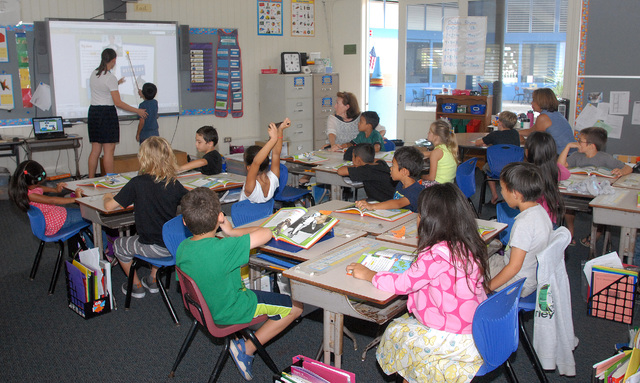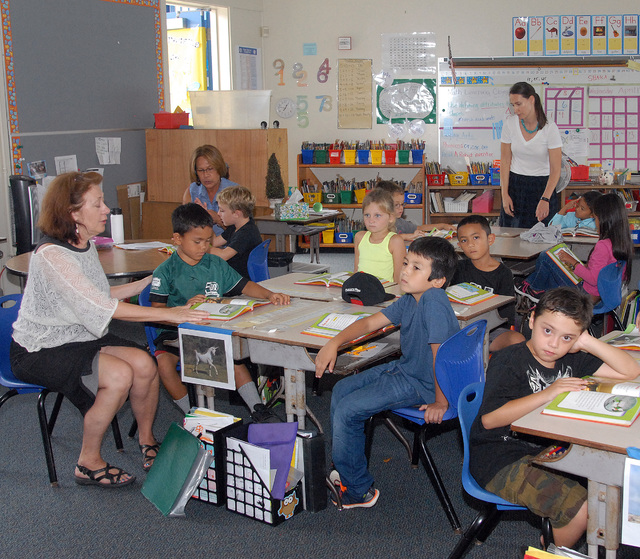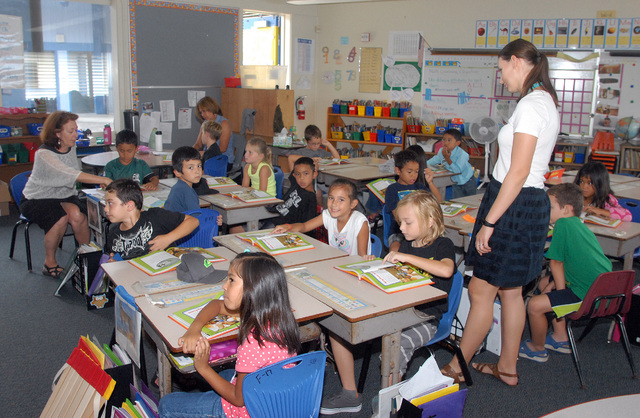Wanted: Qualified teachers
KAILUA-KONA — As the school year winds down, the Hawaii Department of Education again faces the challenge of filling empty desks at the front of its classrooms.
ADVERTISING
Lots of empty desks.
“HIDOE anticipates the need to hire more than 1,000 new teachers for School Year 2016-17 statewide,” Derek Inoshita, a spokesman for the department, summed up in an email.
Hawaii Island isn’t immune to the shortfall. Far from it.
The Big Island is staring down the barrel of 82 teaching vacancies heading into next year, according to departmental numbers obtained on April 21. Of the 82 vacancies, 39 involve special education — an area the state has struggled to staff in part because of the limited number of certified SPED teachers available nationwide.
West Hawaii Area complexes have the greatest number of vacant positions in Hawaii County, where schools need to fill 47 spots.
Wilfred Murakami, principal at Kealakehe High School, noted two primary factors contributing to a higher number of teacher shortages on the west side of the island as compared to other areas — the cost of living and the amount of travel required.
Murakami said the general concerns about teaching in Hawaii are magnified when it comes to pursuing an educational career in the greater-Kona region of the Big Island.
“The distances teachers have to travel, the cost of living, the cost of gas and the cost of electricity here in Kona are quite expensive compared to Hilo,” Murakami said. “Home prices are high, and that’s part of the strain. After a couple years looking at the rent and how that equates to the mainland, it becomes a factor if (teachers) can’t afford to buy a home.”
Hawaii State Teachers Association President Corey Rosenlee agreed that the most significant obstacle to attracting educators to teach anywhere in the state boils down to salary. Teachers in Hawaii make less than they could in most other districts throughout the country where the cost of living is similar. Pay scale for incoming teachers is dependent on an applicant’s teaching experience, education level and whether he or she has a Hawaii teaching license.
A first-year educator with a bachelor’s degree who doesn’t have a Hawaii teaching license — even if he or she was previously licensed in another state — will earn $35,324 annually. A first-year teacher with a bachelor’s degree and a Hawaii teaching license will start at a salary of $46,601.
Regardless of experience and licensing, an applicant without a doctorate degree will start his or her career in Hawaii earning $53,394 per year or less.
But base salary isn’t the only obstacle to the enticement of mainland teachers.
The DOE released a link to a fact sheet on Facebook Tuesday, because of what it called an “overwhelming response received due to recent media coverage regarding the department’s teacher recruitment efforts.”
The fact sheet answers frequently asked questions of those considering migrating to Hawaii to teach.
It specifies that the DOE offers no relocation or signing bonuses, nor will it provide financial housing assistance of any sort to teachers upon their arrival in Hawaii.
The fact sheet also explains that the DOE sets up the application process as a teacher applicant pool, meaning that prospective employees can’t actually apply to specific jobs. Instead, based on a departmental evaluation of a teacher’s qualifications, the DOE matches the teacher with needs throughout public schools statewide with a focus on trying to place educators in the geographical preference specified on their applications.
According to the department, SPED and secondary-level math, science and English are the areas of greatest shortage, and thus, the areas of highest need.
Rachelle Matsumura — interim principal at Honokaa High and Intermediate, which is within the West Area complex along with Kealakehe — said there aren’t enough graduates coming out of universities who are interested in pursuing jobs in those areas.
The rural locale of Honokaa compounds the issue at her school, creating a need for long-term substitutes, who are also in short supply.
“The challenges are making sure people are in the classrooms, and that they are certified to be there,” Matsumura said.
Many of the substitutes who rotate through Matsumura’s classrooms have college degrees, but often not in the lines in which they end up teaching. A primary goal at Honokaa is avoiding any increase in class sizes, but the staffing choices such avoidance necessitates can also produce adverse affects on students.
“It does impede the education of students when teachers are not certified, and that is the big concern,” Matsumura said. “They’re there, they’re doing the best that they can, and we try to do a lot of professional development. We have the counselors and a lot of support staff going in, but it’s kind of a Band-Aid for the problem.”
The other two educational regions on the island — the Ka‘u/Keaau/Pahoa and Hilo/Waiakea areas — are not struggling as mightily as those located on the west side of Hawaii County. Ka‘u/Keaau/Pahoa complexes need to fill 25 positions heading into 2016-17, while Hilo/Waiakea complexes must fill 10 vacant positions.
Hilo/Waiakea Area Superintendent Brad Bennett credited his region’s ability to retain educators in part to Kahua — a place-based program in partnership with Kamehameha Schools that instructs its educators on the historical significance of the region and its local culture.
“Some of the teachers we get are fresh off a plane, and they don’t really know what the local culture is like,” Bennett said. “Learning the history of the area helps them relate to students better and know what to expect when they work with our families.”
While Hilo/Waiakea has battled teaching shortages with relative efficacy, it has not been immune to the statewide deficiency in SPED staffing, as 60 percent of the area’s vacancies exist in special education.
One way Bennett is trying to attack the problem within the problem is with a Response to Intervention program. RIT focuses on supporting students in a general education setting to alleviate some of the need for SPED teachers.
Theoretically, RIT should also help improve Hawaii’s inclusion numbers, which are well below the national average.
Inclusion refers to teaching SPED students in a general education environment as frequently as possible, an effort mandated by federal law and a goal of educational institutions nationwide.
“It provides support in a general education environment rather than moving students to another class,” said Bennett. He described the process as pushing support into classrooms through team teaching and professional development, geared at equipping general education teachers to handle students who may have difficulties.
“We’re making sure if we’re going to identify students as SPED, they truly are SPED.”
Email Max Dible at mdible@westhawaiitoday.com.





